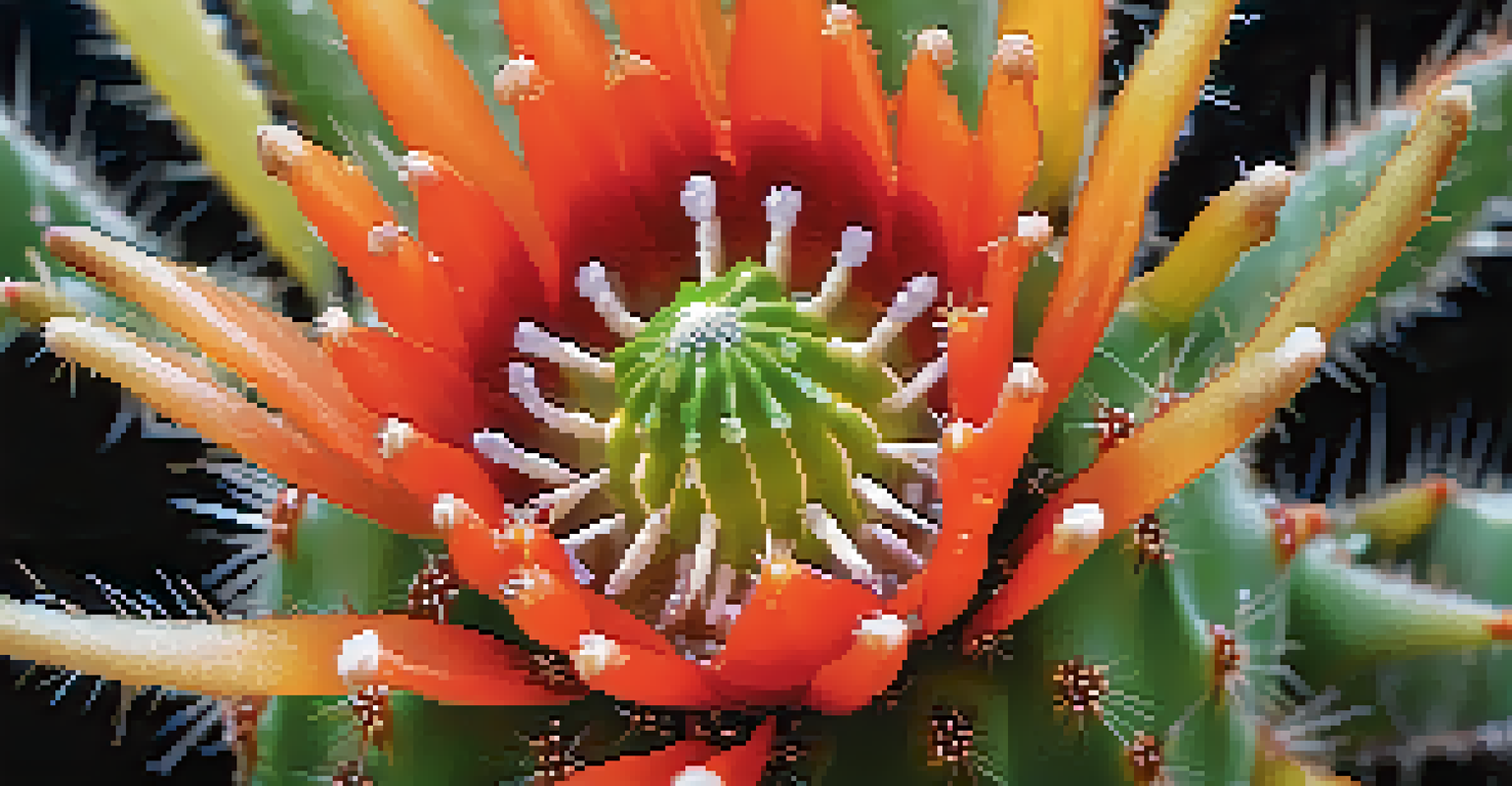Historical Context of Peyote Use in Indigenous Meditation Rituals

Origins of Peyote: A Sacred Plant for Indigenous Peoples
Peyote, a small cactus native to the southwestern United States and northern Mexico, has been used for thousands of years by Indigenous peoples. Its psychoactive properties have made it a crucial element in spiritual and healing practices. The plant holds deep cultural significance, often viewed as a gift from the Creator, facilitating a connection between the physical and spiritual realms.
Peyote is a sacred plant that connects us to our ancestors and the natural world, offering profound insights and healing.
Archaeological evidence suggests that peyote use dates back over 5,000 years, with early records of its consumption emerging from ancient Mesoamerican cultures. This long-standing relationship illustrates how peyote is not merely a substance but a vital part of Indigenous identity and tradition. Stories passed down through generations highlight the reverence with which peyote is treated.
For many tribes, peyote serves as a bridge to the spiritual world, offering insights and guidance. Its role in ceremonies underscores the importance of maintaining a respectful and sacred approach to its use, reflecting broader themes of connection to nature and community.
Peyote in Rituals: A Path to Spiritual Awakening
Indigenous rituals involving peyote often center around communal gatherings, where participants seek spiritual healing and enlightenment. The ceremonies typically involve singing, drumming, and storytelling, creating an atmosphere of unity and shared purpose. Through these practices, individuals can explore their inner worlds and gain clarity on personal and communal challenges.

During a peyote ceremony, participants consume the cactus in a controlled environment, guided by a knowledgeable leader, often referred to as a 'roadman.' This structured approach helps ensure that the experience is meaningful and safe. The use of peyote in this context is seen as a tool for self-discovery and a way to foster connections with ancestors and the natural world.
Modern Ethical Considerations
The growing interest in peyote outside Indigenous communities raises important questions about cultural appropriation and the need for respectful engagement.
The transformative experiences reported by participants often lead to profound insights, emotional healing, and a deeper understanding of one’s place in the universe. These outcomes are essential for reinforcing community bonds and promoting collective well-being, showcasing the holistic nature of Indigenous spirituality.
Cultural Significance of Peyote in Indigenous Communities
Peyote is more than a ceremonial substance; it embodies the cultural identity of many Indigenous communities. For these groups, the use of peyote is intertwined with traditional beliefs, values, and practices. It serves as a symbol of resistance and resilience, especially in the face of historical oppression and cultural erasure.
To understand peyote is to understand the resilience of Indigenous cultures and the deep respect for nature that they embody.
In many Indigenous cultures, the teachings gained from peyote experiences are shared and integrated into daily life, influencing everything from social norms to individual behavior. The wisdom imparted during rituals emphasizes respect for the earth, community, and the interconnectedness of all living things. This cultural framework is vital for fostering a sense of belonging and purpose.
Moreover, the ongoing struggle to protect peyote’s sacred status reflects broader issues of Indigenous rights and sovereignty. Advocates stress the importance of maintaining traditional practices as a way to preserve cultural heritage and promote healing for future generations.
The Impact of Colonization on Peyote Practices
Colonization has had a profound impact on Indigenous practices surrounding peyote, often leading to suppression and misunderstanding. European settlers frequently viewed peyote use through a lens of stigma and criminalization, disregarding its cultural significance. This disconnect resulted in policies that aimed to eradicate the use of peyote and, by extension, Indigenous spiritual practices.
As Indigenous communities faced increasing pressure to abandon their traditions, many turned to peyote as a form of resistance. The plant became a symbol of cultural survival, and its use persisted despite external challenges. This resilience highlights the importance of peyote in maintaining cultural identity and fostering community cohesion.
Peyote's Cultural Importance
Peyote is a sacred plant that embodies the cultural identity and spiritual practices of many Indigenous communities.
Today, many Indigenous groups advocate for the legal protection of peyote use, emphasizing its importance in spiritual and cultural contexts. This ongoing fight for recognition reflects broader themes of justice, healing, and the reclamation of Indigenous rights.
Modern Perspectives on Peyote Use
In recent years, the use of peyote has gained attention beyond Indigenous communities, with some people exploring its potential benefits for mental health and personal growth. This interest has sparked conversations around cultural appropriation and the ethical considerations of using sacred plants outside their traditional contexts. It's essential to approach these discussions with sensitivity and respect for Indigenous knowledge and practices.
Many Indigenous leaders emphasize that while they welcome interest in peyote, it must come with a deep understanding of its cultural significance. Engaging with Indigenous communities and respecting their practices is crucial in any exploration of peyote. This ensures that the plant is used in a manner that honors its traditions and the people who have safeguarded its legacy.
As society continues to grapple with issues of mental health and well-being, understanding the historical context of peyote use can offer valuable insights. It serves as a reminder of the importance of integrating traditional wisdom into contemporary healing practices, fostering a dialogue that respects both Indigenous heritage and modern needs.
Legal Challenges Surrounding Peyote Use
The legal status of peyote in the United States is complex and often contentious. While peyote is classified as a controlled substance, certain provisions allow its use in religious ceremonies for recognized Indigenous groups. This legal framework aims to protect the cultural practices of these communities but can also create challenges for their members, especially when navigating state and federal regulations.
The Native American Church (NAC) has played a pivotal role in advocating for the rights of Indigenous peoples to use peyote in their spiritual practices. Through legal battles and lobbying efforts, the NAC has worked to secure protections for peyote use, helping to establish a precedent for religious freedom. This ongoing advocacy underscores the importance of peyote as a sacred element of Indigenous spirituality.
Resilience Against Colonization
Despite the challenges posed by colonization, peyote has become a symbol of resistance and cultural survival for Indigenous peoples.
However, the future of peyote remains uncertain, particularly due to overharvesting and environmental concerns. As demand increases, the sustainability of peyote populations becomes a pressing issue, prompting discussions about conservation efforts and the ethical implications of its use.
Conclusion: Honoring the Legacy of Peyote Use
The historical context of peyote use in Indigenous meditation rituals offers a rich tapestry of cultural significance, resilience, and spiritual connection. Understanding this legacy is essential for appreciating the depth of Indigenous traditions and the ongoing struggle for cultural recognition. As we engage with the topic of peyote, it’s vital to approach it with an open heart and mind, acknowledging the wisdom of those who have used it for generations.
Furthermore, fostering respectful dialogue about peyote use can help bridge the gap between Indigenous knowledge and contemporary practices, creating a space for mutual learning and understanding. This dialogue is crucial in promoting cultural appreciation rather than appropriation, ensuring that Indigenous voices remain at the forefront of these discussions.

Ultimately, recognizing the history and significance of peyote is a step toward honoring the legacy of Indigenous peoples. By valuing their traditions and advocating for their rights, we can contribute to a more inclusive and respectful understanding of this sacred plant and its place in the world.